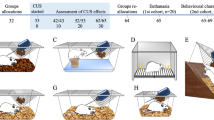Anhedonia is one of the central features of the development of depression. Chronic stress leads to the development of depression-like behavior in experimental animals, which in particular is expressed as impairments to the consumption of and/or preference for tasty meals or drinks, i.e., anhedonia. We report here studies of the development of chronic unpredictable stress-induced anhedonia in animals previously separated into groups on the basis of activity in the forced swimming test. Anhedonia was assessed weekly in terms of the level of consumption and at the end of the experiment in terms of the preference for sucrose solution. Chronic unpredictable stress in rats led to the development of anhedonia, apparent as a decrease in the preference for sucrose solution. The link between the animals’ initial behavior in the forced swimming test and the development of anhedonia was not straightforward. Despite the fact that the probability of developing anhedonia was higher in rats with initially higher levels of activity in the forced swimming test (assessed in terms of the number of animals demonstrating anhedonia), groups of animals resistant and sensitive to chronic stress as assessed in terms of anhedonia showed no significant differences in their initial behavioral characteristics in the forced swimming test.
Similar content being viewed by others
References
American Psychiatric Association (APA), Diagnostic and Statistical Manual of Mental Disorders, American Psychiatric Publishers, Arlington, VA(2013).
Armario, A. and Nadal, R., “Individual differences and the characterization of animal models of psychopathology: a strong challenge and a good opportunity,” Front. Pharmacol., 4, 137 (2013).
Bisgaard, C. F., Jayatissa, M. N., Enghild, J. J., et al., “Proteomic investigation of the ventral rat hippocampus links DRP-2 to escitalopram treatment resistance and SNAP to stress resilience in the chronic mild stress model of depression,” J. Mol. Neurosci., 32, 132–144 (2007).
Christensen, T., Bisgaard, C. F., and Wiborg, O., “Biomarkers of anhedonic-like behavior, antidepressant drug refraction, and stress resilience in a rat model of depression,” Neuroscience, 196, 66–79 (2011).
Grigor’yan, G. A. and Gulyaeva, N. V., “Modeling depression in animals: methodology, assessment criteria, and classifi cation,” Zh. Vyssh. Nerv. Deyat., 65, 643–660 (2015).
Grønli, J., Bramham, C., Murison, R., et al., “Chronic mild stress inhibits BDNF protein expression and CREB activation in the dentate gyrus but not in the hippocampus proper,” Pharmacol. Biochem. Behav., 85, 842–849 (2006).
Grønli, J., Murison, R., Bjorvatn, B., et al., “Chronic mild stress affects sucrose intake and sleep in rats,” Behav. Brain Res., 150, 139–147 (2004).
Grønli, J., Murison, R., Fiske, E., et al., “Effects of chronic mild stress on sexual behavior, locomotor activity and consumption of sucrose and saccharine solutions,” Physiol. Behav., 84, 571–577 (2005).
Li, Y., Zheng, X., Liang, J., and Peng, Y., “Coexistence of anhedonia and anxiety-independent increased novelty-seeking behavior in the chronnormalic mild stress model of depression,” Behav. Processes, 83, 331–339 (2010).
Murray, R., Boss-Williams, K. A., and Weiss, J. M., “Effects of chronic mild stress on rats selectively bred for behavior related to bipolar disorder and depression,” Physiol. Behav., 119, 115–129 (2013).
Nasca, C., Bigio, B., Zelli, D., et al., “Mind the gap: glucocorticoids modulate hippocampal glutamate tone underlying individual differences in stress susceptibility,” Mol. Psychiatry, 20, 755–763 (2015).
Naudon, L. and Jay, T. M., “Opposite behaviours in the forced swimming test are linked to differences in spatial working memory performances in the rat,” Neuroscience, 130, 285–293 (2005).
Papp, M., “Models of affective illness: chronic mild stress in the rat,” Curr. Protoc. Pharmacol., Ch. 5, Unit 5, 9 (2012), doi: https://doi.org/10.1002/0471141755.ph0509s57
Sequeira-Cordero, A., Mora-Gallegos, A., Cuenca-Berger, P., and Fornaguera-Trías, J., “Individual differences in the immobility behavior in juvenile and adult rats are associated with monoaminergic neurotransmission and with the expression of corticotropin-releasing factor receptor 1 in the nucleus accumbens,” Behav. Brain Res., 252, 77–87 (2013).
Stepanichev, M. Yu., Peregud, D. I., Manolova, A. O., et al., “Moderate chronic stress increases the expression of the genes for proinfl ammatory cytokines in the rat brain,” Izv. Ros. Akad. Nauk. Ser. Biol., No. 1, 63–69 (2018).
Stepanichev, M. Yu., Tishkina, A. O., Novikova, M. R., et al., “Anhedonia but not passive floating is an indicator of depressive-like behavior in two chronic stress paradigms,” Acta Neurobiol. Exp. (Wars.), 76, 324–333 (2016).
Strekalova, T. and Steinbusch, H. W., “Measuring behavior in mice with chronic stress depression paradigm,” Prog. Neuropsychopharmacol. Biol. Psychiatry, 34, 348–361 (2010).
Valverde, O., Smadja, C., Roques, B. P., and Maldonado, R., “The attenuation of morphine-conditioned place preference following chronic mild stress is reversed by a CCKB receptor antagonist,” Psychopharmacology (Berl.), 131, 79–85 (1997).
Weiss, J. M., Cierpial, M. A., and West, C. H., “Selective breeding of rats for high and low motor activity in a swim test: toward a new animal model of depression,” Pharmacol. Biochem. Behav., 61, 49–66 (1998).
Weiss, J. M., West, C. H., Emery, M. S., et al., “Rats selectively bred for behavior related to affective disorders: proclivity for intake of alcohol and drugs of abuse, and measures of brain monoamines,” Biochem. Pharmacol., 75, 134–159 (2008).
Willner, P., “Chronic mild stress (CMS) revisited: consistency and behavioural- neurobiological concordance in the effects of CMS,” Neuropsychobiology, 52, 90–110 (2005).
Willner, P., “Validity, reliability and utility of the chronic mild stress model of depression: a 10-year review and evaluation,” Psychopharmacology (Berl.), 134, 319–329 (1997).
Author information
Authors and Affiliations
Corresponding author
Additional information
Translated from Zhurnal Vysshei Nervnoi Deyatel’nosti imeni I. P. Pavlova, Vol. 68, No. 4, pp. 488–495, July–August, 2018.
Rights and permissions
About this article
Cite this article
Manolova, A.O., Stepanichev, M.Y. & Gulyaeva, N.V. Behavior of Rats in a Forced Swimming Test Is Not an Unambiguous Predictor for the Development of Anhedonia in Chronic Stress. Neurosci Behav Physi 49, 1016–1021 (2019). https://doi.org/10.1007/s11055-019-00831-y
Received:
Accepted:
Published:
Issue Date:
DOI: https://doi.org/10.1007/s11055-019-00831-y




